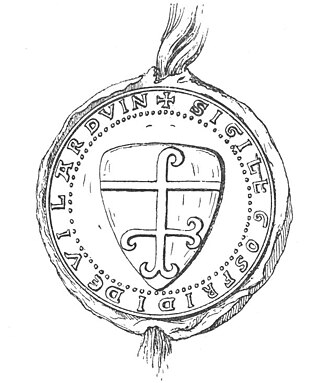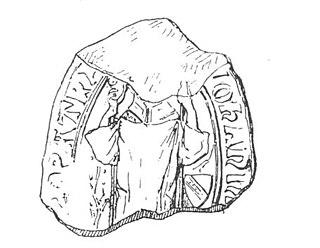Related Research Articles

The Peloponnese, Peloponnesus or Morea is a peninsula and geographic region in southern Greece, and the southernmost region of the Balkans. It is connected to the central part of the country by the Isthmus of Corinth land bridge which separates the Gulf of Corinth from the Saronic Gulf. From the late Middle Ages until the 19th century, the peninsula was known as the Morea, a name still in colloquial use in its demotic form.

The Principality of Achaea or Principality of Morea was one of the vassal states of the Latin Empire, which replaced the Byzantine Empire after the capture of Constantinople during the Fourth Crusade. It became a vassal of the Kingdom of Thessalonica, along with the Duchy of Athens, until Thessalonica was captured by Theodore, the despot of Epirus, in 1224. After this, Achaea became for a while the dominant power in Greece.

William I of Champlitte (1160s-1209) was a French knight who joined the Fourth Crusade and became the first prince of Achaea (1205–1209).

Geoffrey I of Villehardouin was a French knight from the County of Champagne who joined the Fourth Crusade. He participated in the conquest of the Peloponnese and became the second prince of Achaea.

Methoni is a village and a former municipality in Messenia, Peloponnese, Greece. Since the 2011 local government reform it is part of the municipality of Pylos-Nestor, of which it is a municipal unit. The municipal unit has an area of 97.202 km2. Its name may be derived from Mothona, a mythical rock. It is located 11 km south of Pylos and 11 km west of Foinikounta. The municipal unit of Methoni includes the nearby villages of Grizokampos, Finikouda, Foiniki, Lachanada, Varakes, Kainourgio Chorio, Kamaria, Evangelismos, and the Oinnoussai Islands. The islands are Sapientza, Schiza, and Santa Marina; they form a natural protection for Methoni harbour. The town is also known by the Italian name Modone, which it was called by the Venetians.

Koroni or Corone is a town and a former municipality in Messenia, Peloponnese, Greece. Since the 2011 local government reform it is part of the municipality Pylos-Nestor, of which it is a municipal unit. Known as Corone by the Venetians and Ottomans, the town of Koroni sits on the southwest peninsula of the Peloponnese on the Gulf of Messinia in southern Greece, 56 km (35 mi) by road southwest of Kalamata. The town is nestled on a hill below a Venetian castle and reaches to the edge of the gulf. The town was the seat of the former municipality of Koróni, which has a land area of 105 km2 (41 sq mi) and a population of 4,366. The municipal unit consists of the communities Akritochori, Charakopio, Chrysokellaria, Falanthi, Kaplani, Kompoi, Koroni, Vasilitsi, Vounaria and Iamia. It also includes the uninhabited island of Venétiko.
The Diocese or Bishopric of Amyclae is a defunct Latin and Orthodox episcopal see and suppressed Latin Catholic titular bishopric in the Peloponnese, in peninsular Greece.

The Frankokratia, also known as Latinokratia and, for the Venetian domains, Venetokratia or Enetokratia, was the period in Greek history after the Fourth Crusade (1204), when a number of primarily French and Italian states were established by the Partitio terrarum imperii Romaniae on the territory of the dissolved Byzantine Empire.

The Latin Archbishopric of Patras was the see of Patras in the period in which its incumbents belonged to the Latin Church. This period began in 1205 with the installation in the see of a Catholic archbishop following the Fourth Crusade.

The Kingdom of the Morea or Realm of the Morea was the official name the Republic of Venice gave to the Peloponnese peninsula in southern Greece when it was conquered from the Ottoman Empire during the Morean War in 1684–99. The Venetians tried, with considerable success, to repopulate the country and reinvigorate its agriculture and economy, but were unable to gain the allegiance of the bulk of the population, nor to secure their new possession militarily. As a result, it was lost again to the Ottomans in a brief campaign in June–September 1715.

The Barony of Vostitsa was a medieval Frankish fiefdom of the Principality of Achaea, located in the northern coast of the Peloponnese peninsula in Greece, centred on the town of Vostitsa.

The Barony of Patras was a medieval Frankish fiefdom of the Principality of Achaea, located in the northwestern coast of the Peloponnese peninsula in Greece, centred on the town of Patras. It was among the twelve original baronies of the Principality of Achaea, but passed into the hands of the Latin Archbishop of Patras at about the middle of the 13th century. From 1337 on, Patras was an ecclesiastical domain de facto independent of the Principality, although the archbishops still recognized its suzerainty for their secular fiefs. The archbishops maintained close relations with the Republic of Venice, which governed the barony in 1408–1413 and 1418. The barony survived until the Byzantine reconquest in 1429–30.

The Barony of Veligosti or Veligosti–Damala was a medieval Frankish fiefdom of the Principality of Achaea, originally centred on Veligosti in southern Arcadia, but also came to include the area of Damala in the Argolid when it came under a cadet branch of the de la Roche family in the 1250s. After Veligosti was lost to the Byzantines towards 1300, the name was retained even though the barony was reduced to Damala.
Andronikos Asen Zaccaria or Asanes Zaccaria was a Genoese lord of the Principality of Achaea in southern Greece.
The Metropolis of Corinth, Sicyon, Zemenon, Tarsos and Polyphengos is a metropolitan see of the Church of Greece in Corinthia, Greece. Since the Middle Ages it has also existed as a Roman Catholic titular see. The current metropolitan is Dionysios Mantalos.
The Treaty of Sapienza was concluded in June 1209 between the Republic of Venice and the newly established Principality of Achaea, under Prince Geoffrey I of Villehardouin, concerning the partition of the Peloponnese (Morea) peninsula, conquered following the Fourth Crusade. By its terms, Venice, which had been accorded most of the Peloponnese in the Partitio Romaniae, recognized Villehardouin in possession of the entire peninsula except for the two forts of Modon and Coron, which came under Venetian control, and secured commercial and tax privileges in the Principality. The text of the treaty is also a valuable primary source for the early history of the Principality of Achaea.
Stephen Zaccaria was the youngest brother of the last Prince of Achaea, Centurione II Zaccaria, and Latin Archbishop of Patras from 1404 until his death in 1424.
The Diocese of Lacedaemon o Lacedaemonia was a Christian ecclesiastical province in Laconia, Greece. Extant from at least the middle of the 5th century, it became a metropolis in 1083. During the period of Frankish rule, between ca. 1209 and 1278, it was held by Roman Catholic prelates, and remains a (vacant) titular see of the Catholic Church. The Greek Orthodox see was restored with the Byzantine reconquest in the 1270s, and continued until the see's abolition in 1852.
The Second Parliament of Ravennika was convened in May 1210 by Latin Emperor Henry of Flanders in the town of Ravennika in Central Greece in order to resolve the differences between the princes of Frankish Greece and the Roman Catholic clergy of their domains.
The Metropolis of Elis and Olena is a Greek Orthodox episcopal see of the Church of Greece. During the period of Frankish rule it was a Roman Catholic see, and continues to the present day as a titular see in the Roman Catholic Church.
References
- 1 2 3 Pétridès, Sophron (1913). . In Herbermann, Charles (ed.). Catholic Encyclopedia . New York: Robert Appleton Company.
- 1 2 3 Gregory (1991), pp. 531–533
- ↑ Setton (1975), pp. 21–24
- ↑ Bon (1969), pp. 56–59
- ↑ Setton (1975), pp. 22–25, 36
- ↑ Setton (1975), pp. 36–38
- ↑ Bon (1969), pp. 93–94
- ↑ Bon (1969), pp. 478–480
- ↑ Bon (1969), p. 114
- ↑ Bon (1969), p. 92
- ↑ Vakalopoulos (1975), p. 209




